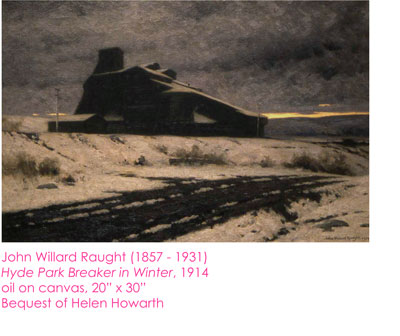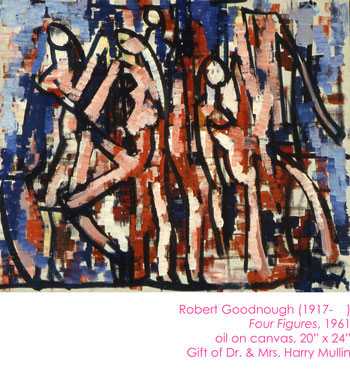
 |
 | |
 |
Although the Everhart Museum has been around since 1908, our collecting of fine art didn't really start until 1929. Since that time, we have collected works from all over the world. We are especially proud of the pieces done by local artists like John Willard Raught, Priscilla Longshore Garrett, and Hope Horn, among others. You'll have to stop by and take a look! Quite often people worry about getting the "meaning" of a painting. The truth is, many times no one but the artist knows what the work's about. That said, a lot of times you can figure out what's going on, just by looking for the clues the artist has left. See how you do with the painting from our collection below: |
 | |
 A portrait is what we call a painting that has a person - or several people - in it. Even though you might not know who the person is, you can often figure out a lot just by looking. Some of the best spots to check out? The person's face, body, and clothes; the background; and other objects in the painting. A portrait is what we call a painting that has a person - or several people - in it. Even though you might not know who the person is, you can often figure out a lot just by looking. Some of the best spots to check out? The person's face, body, and clothes; the background; and other objects in the painting.Here. Try it. Look closely at the woman to the right. Can you answer the following questions?
We bet you were able to learn quite a bit about this woman, even though we'll never know her name! | |
 | |
 A landscape is a work about the out-of-doors. It can be of the country or city. The seashore or the desert. A river or a highway. No matter what else is in it - even people - if it's outside, it's a landscape. A landscape is a work about the out-of-doors. It can be of the country or city. The seashore or the desert. A river or a highway. No matter what else is in it - even people - if it's outside, it's a landscape.Just like with a portrait, by looking closely you can learn a lot about why the artist picked this place to paint. Just take a look to the left. The building in the middle of the painting is called a breaker. Inside the breaker, coal would be crushed into little pieces to heat homes and power trains. People - some as young as eight - would work inside for ten hours a day. | |
 | |
 Lots of people think still lifes are boring. It's just a bunch of stuff - like fruit, bowls, and bottles - placed on a table, that doesn't move. In truth, still lifes are one of the hardest things an artist can do, and one of the best ways to develop his or her skills. To do a still life well, one needs to really study the objects, looking at their shape, how the light hits them, and where the shadows fall. This is especially tricky when you start putting lots of objects next to each other! Lots of people think still lifes are boring. It's just a bunch of stuff - like fruit, bowls, and bottles - placed on a table, that doesn't move. In truth, still lifes are one of the hardest things an artist can do, and one of the best ways to develop his or her skills. To do a still life well, one needs to really study the objects, looking at their shape, how the light hits them, and where the shadows fall. This is especially tricky when you start putting lots of objects next to each other!Some of the best artists in the world are famous for their still lifes, like Cezanne, Picasso, Van Gogh, Matisse, Escher, and even Warhol. The painting you see to the left is a little different than the traditional still life in that it doesn't try to look realistic (really real). In fact, this painting doesn't seem very still at all! Take a look at some of these features: | |
 | |
 Abstract art scares a lot of people. Not because it's like a big monster hiding under your bed, but because it doesn't look really real and people are afraid they won't "get" it. Sometimes it doesn't look like anything at all. Artists make abstract art for lots of reasons, like to show energy, emotion, or a belief. Abstract art scares a lot of people. Not because it's like a big monster hiding under your bed, but because it doesn't look really real and people are afraid they won't "get" it. Sometimes it doesn't look like anything at all. Artists make abstract art for lots of reasons, like to show energy, emotion, or a belief.Even though you can see the people in this painting to the right, they don't look like they would if Mr. Goodnough had taken a photograph. Let's see if we can figure out why he did this.
|